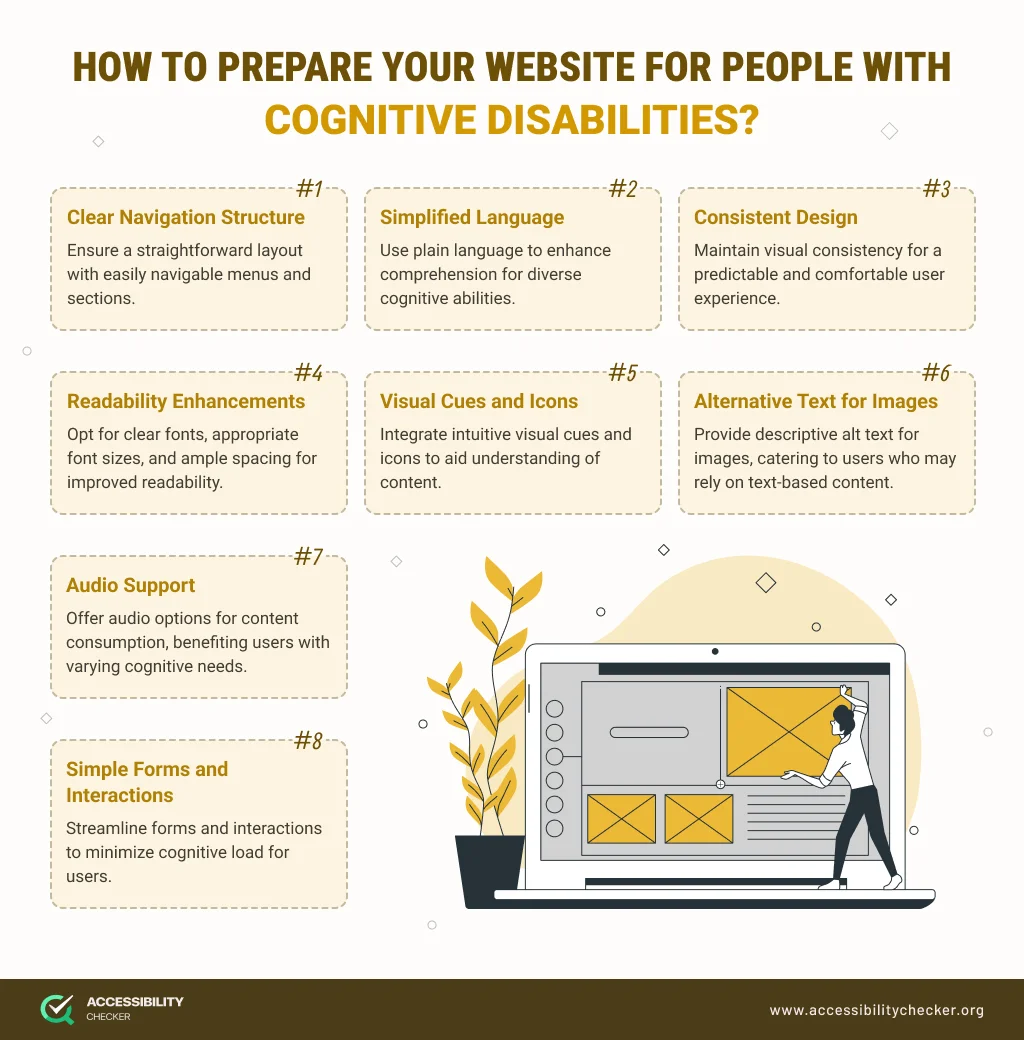Navigating Cognitive Accessibility Essentials
As many as 200 million people (1) in the world are currently living with a cognitive disability, with low-income countries having higher percentages.
A person with a cognitive disability has trouble remembering information, concentrating, and making basic decisions, which can alter the way they use online platforms and consume content.
The Web Content Accessibility Guidelines (WCAG) include guidance on how website owners can cater to users with cognitive disabilities, which we will outline later in this article.

What is Cognitive Accessibility?
Cognitive accessibility is the process of developing online spaces and platforms that cater to users with cognitive disabilities.
Cognitive disabilities include intellectual disabilities, mental disabilities, and learning disabilities.
The goal is for websites, mobile applications, and digital content in general to accommodate the needs of people living with these types of impairments.
Why Is Cognitive Accessibility Important?
When you consider that nearly 13% of all people living in the United States (2) alone have a cognitive disability, you quickly realize just how many users you may be isolating by not adhering to WCAG guidelines.
By using WCAG as a guideline to achieve cognitive accessibility, you are also complying with global disability acts such as the ADA and the AODA in Canada. Businesses that fail to comply could be left dealing with costly lawsuits, not to mention long-lasting brand damage.
Brands that prioritize and promote inclusivity are also more likely to retain customers who share the same values, making accessibility a worthwhile effort in general.
Examples of Cognitive Disabilities
Cognitive disabilities usually fall into one of three categories:
Intellectual Disabilities
People with intellectual disabilities have limited cognitive functions, which include language, social, conceptual, and self-care capabilities. An intellectual disability usually presents early on in life and results in an IQ level of 70 or lower.
Some examples of intellectual disabilities include Down syndrome, fetal alcohol syndrome, anoxia, fragile X syndrome, and any other damage resulting from traumatic brain injuries or strokes.
Mental Disabilities
A mental disability is a cognitive impairment that limits daily activities. It’s often caused by biological or environmental factors, but substance abuse and brain trauma are also causes.
Some of the most common mental disabilities are PTSD, bipolar disorder, schizophrenia, personality disorder, anxiety, and depression.
Keep in mind that these conditions are only deemed to be a disability if they severely impact someone’s ability to work and carry out normal daily activities.
Learning Disabilities
A learning disability makes it more challenging for a person to learn and comprehend. For example, someone may find it difficult to understand spoken or written language, perform calculations, or coordinate their movements.
Examples of learning disabilities include attention deficit hyperactivity disorder (ADHD), dyslexia, developmental coordination disorder (DCD), dysgraphia, developmental language disorder (DLD), Autism spectrum disorder (ASD), and dyscalculia.
Over and above these categories, website owners should also keep age-related disabilities such as dementia and Alzheimer’s in mind.
How to Prepare Your Website for People with Cognitive Disabilities
People with cognitive disabilities aren’t always able to navigate a website in the same way as everyone else.
Many won’t be able to comprehend confusing jargon, use web forms, or complete tasks in a specific amount of time. Understanding and following provided instructions to complete an action/ activity is also difficult for such users.
Here are some of the steps you can take to improve the online experience for these users based on WCAG requirements.
Maintain Predictability
It’s important to ensure your website has a predictable and logical flow. A user should be able to get around with ease and know how to get back to certain pages – a simple and consistent navigation helps with this.
Avoid distracting elements such as pop-ups wherever possible, or at least make sure a user knows how to close them. The same applies to distracting elements such as flashing graphics. Any graphic that flashes more than three times in one second should be disabled.
Write Clearly and Concisely
Depending on the type of site you’re running, complex writing may be necessary. However, if you can avoid jargon, you should.
Basic terminology and simple language are preferred and will appeal to more people.
If you must use wording that’s more technical, consider adding a glossary or an alternative section with simpler wording to your site that’s easy to access.
In terms of the layout of your content, make sure you’re using the right headings (H1, H2, H3) to break up paragraphs. Bullet points will also make your content easier to read.
Prioritize Visual Distinguishability
Someone with a cognitive disability may find it difficult to distinguish between different elements on a web page.
To improve the user experience, make sure there is sufficient contrast between various site elements. WCAG requires a minimum contrast ratio of 4.5:1 for all text. For very large text and non-text informative UI components, the ratio can be as low as 3:1.
There should also be sufficient spacing between all elements and users should have the ability to pause and stop audio. Background audio content that plays automatically can make it difficult for a user to distinguish what they’re hearing in a video on your site.
Avoid Time and Memory-Based Processes
Wherever possible, try not to implement on-site processes that need to be completed in a specific amount of time or rely on memory for completion.
Make it possible for a user to pause any timed content and give them the ability to auto-complete forms – many disabled users have this function setup on their devices.
It’s also best to avoid any CAPTCHA test that requires image identification or the completion of puzzles. And if necessary, ensure the CAPTCHA has more than one ways, including visual and auditory puzzles, to be resolved.
Provide Input Assistance
The point of input assistance is to reduce the chances of a visitor with a cognitive disability making a mistake on your site, resulting in a frustrating experience.
Should a user make an error while browsing, they should be notified using clear and descriptive text. The message should ideally also be accompanied by an icon, color, or image that further highlights there’s been an error.
Any forms should always have text-based instructions to ensure they’re as easy to complete as possible. It also helps to provide someone with suggestions if an input error occurs.
Lastly, give visitors the chance to review a form submission or purchase before it’s submitted for processing. This gives them the opportunity to correct any errors that may have been made.
Conclusion
Cognitive accessibility is an integral part of WCAG guidelines and various global disability acts.
By implementing these recommendations, you can provide your website visitors with a memorable, user-friendly experience, leading to customer loyalty and a stronger brand overall.


